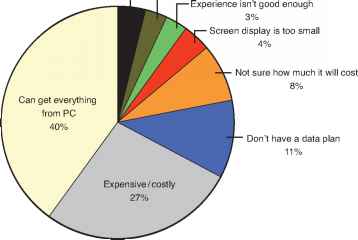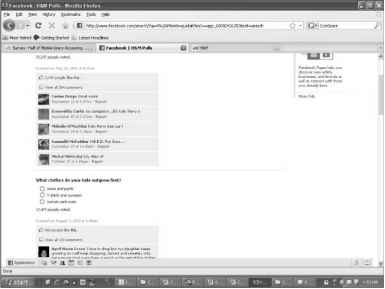Targeting Your Mobile Customers
As discussed elsewhere in this book, not everyone is an ideal candidate to receive your mobile marketing messages. For the most part, people with smart phones and true Web browsing phones are far more likely to be compelled by any type of mobile marketing message. In terms of age group, that means only about 8% of Baby Boomers, 18% of Millenials, and 10% of Gen-Xers are likely to be compelled by your mobile marketing messages. Table 3.1 shows what types of smart phones each of these demographics tend to use.
|
Table 3.1 Mobile Phone Usage by Generation1 | ||
|
Millenials (18% Own a Smart Phone) |
Gen X-ers (10% Own a Smart Phone) |
Boomers (8% Own a Smart Phone) |
|
Blackberry: 39% |
Blackberry: 40% |
Blackberry: 39% |
|
iPhone: 20% |
iPhone: 11% |
iPhone: 10% |
|
Sidekick: 15% |
Sidekick: 5% |
Treo: 10% |
|
Treo: 12% |
Treo: 8% |
Sidekick: 10% |
|
Blackjack: 10% |
Blackjack: 3% |
LG enV: 3% |
|
LG enV: 9% |
LG enV: 3% |
T-Mobile Wing: 3% |
|
T-Mobile Wing: 5% |
T-Mobile Wing: 3% |
Nokia N95: 3% |
|
Nokia N95: 4% |
Nokia N95: 3% |
Helio Ocean: 4% |
|
Helio Ocean: 4% |
Other: 19% |
Other: 19% |
|
Other: 14% |
Not sure: 13% |
Not sure: 10% |
|
Not sure: 7% | ||
1 Online survey of 4,000 mobile users in the United States between the ages of 16 and 64, conducted in January 2009 by Frank N. Magid (http://localmobilesearch.net/ news/hardware/survey-half-mobile-users-accessing-content-weekly).
1 Online survey of 4,000 mobile users in the United States between the ages of 16 and 64, conducted in January 2009 by Frank N. Magid (http://localmobilesearch.net/ news/hardware/survey-half-mobile-users-accessing-content-weekly).
These statistics might be slightly disappointing to mobile marketers who assume that the entire world is active on their mobile phones. Unfortunately, although the price of smart phones and mobile data plans continues to drop, many people still either can't afford a smart phone or don't see the value in owning one. A whole other group of people own smart phones but don't use them to access mobile content, as illustrated in Figure 3.1.
What is the primary reason why you do not access the Internet on your mobile?
— Haven't gotten around to trying 3%
— Haven't gotten around to trying 3%

- Figure 3.1 For many reasons, some mobile users don't access the mobile Web on their mobile phones. Chart courtesy of lnternet2Go, localmobilesearch.net.
Age and Gender
According to a 2008 study by m:Metrics, the best demographic you can reach with mobile marketing is men between 18 and 34 years old. This demographic actually had a 9% click-though rate for mobile. Although women in this age group were quite active, they were less likely to click through on an advertisement. A comScore study from 2009 also reports that 70% of iPhone users are male.
Still, women are an important demographic in mobile marketing and should not be ignored. A 2009 study called "Women and Digital Life" reported that females between 12 and 24 named their mobile phone as the most important piece of technology in their life—even more important than a personal computer or laptop. The younger part of this demographic surpassed their older business professional counterparts in terms of mobile Internet usage.
Busy mothers can also be quite a lucrative demographic to target with mobile marketing, partially because they are 43% more likely to download mobile content. A 2009 study by GreyStripe actually renamed part of the "soccer mom" demographic to "iPhone moms." This makes sense, because the report shows that 29% of iPhone owners are women with children. Because they are often the purchase decision makers for the household, they control the purse strings —and are also frequently out of their homes, away from other types of marketing channels.
Some marketers worry that there is a trade-off between different types of mobile activities; for example, if people begin to get involved with one type of mobile activity, such as applications, they will become less involved with another mobile activity, such as online mobile social networking or mobile shopping. As it turns out, the opposite might be true. In a multiplier effect, more mobile activity might beget more mobile activity. A 2009 study of 2,000 mobile consumers by ExactTarget found a correlation between growth in participants' use of mobile email, instant messaging, text messaging, and mobile social networking activities.
As you might expect, different age groups use their mobile phones differently. According to the Magid study referenced in Table 3.1,80% of mobile social networking activity is by people under the age of 34. As shown in Figure 3.2, a 2008 study showed that the highest demographic accessing mobile content was between the ages of 20 and 29. The second-largest group was between the ages of 30 and 39. Teenagers between 16 and 19 were the third largest group, beating out only those 40 to 49 and those 50 and above for their use of the mobile Internet.
Mobile Users Accessing the Internet on Their Mobile Devices, by Age, Income and Gender
Question: Do you access the Internet on your mobile device? (yes, no) Base: U.S. mobile user ages 16+ (n=1,001)
0% - -| 16-19 20-29 30-39 40-49 50+ $35-50K $50K-75K $75K+ Male Female
-| 16-19 20-29 30-39 40-49 50+ $35-50K $50K-75K $75K+ Male Female
Figure 3.2 A 2008 study showed that the largest portion of the mobile market that accesses the mobile Internet is between the ages of 20 and 29. Chart courtesy of iCrossing.

According to GreyStripe—one of the top mobile gaming companies—47% of its mobile gamers are between the ages of 18 and 24, 23% are between 23 and 43, and only 14% are between 13 and 17. Text messaging is the most popular method of communication for people who are ages 13 to 24, and, according to a 2009 post on the Mobile Marketing Blog, their acceptance of this medium is actually growing at a faster rate than email, phone calls, and even social media. A 2008 study by Nielson shows that 35% of those age 13 to 17 actually remember receiving a text message ad, whereas only 10% of those 55 and older do (see Figure 3.3).
Recall of Any Text-Message Advertising Amongst Texters, by Age and Ethnicity (Q2 2008)
Recall Any Text Ad
All Subs 16%
Ages 13 17 35%
Ages 18 24 18%
Ages 25 34 16%
Ages 35 54 12%
Ages 55+ 10%
White 13%
Hispanic 23%
African American 24%
Asian/Pacific Islander 20%
Source: Nielsen Telecom Practice Group
Figure 3.3 You might have guessed it, but this study proves that mobile users between the ages of 13 and 17 are the most likely to remember your text message advertisement. Image courtesy of Nielson Telecom Practice Group.
Income
Mobile consumers tend to be more affluent than their nonmobile counterparts, and the more affluent mobile users tend to rely more heavily on mobile content than those lower on the income scale. According to a 2009 comScore study, mobile consumers with an annual household income of more than $100,000 tend to access business information three times more than those with an income of less than $100,000 per year (see Figure 3.4). They are also two times more likely to consume content from mobile news or mobile shopping websites.
Mobile Browsers With Income $100,000+
|
7,000,000 | |
|
6,000,000 | |
|
<0 |
5,000,000 |
|
(Ü | |
|
tn 3 |
4,000,000 |
|
QJ | |
|
3 CT |
3,000,000 |
|
'S | |
|
3 |
2,000,000 |
|
1,000,000 |

Sports information
Financial Entertainment Tech news news news
Web search
News
Sports information
Financial Entertainment Tech news news news
Figure 3.4 As you might expect, mobile users with annual incomes $100,000 or higher are two times more likely to consume content from mobile news or mobile shopping websites. Chart courtesy of comScore, Inc.
The same survey found that people who are accessing mobile content spend about 39 minutes per week with some type of mobile content, presumably either mobile Web content or mobile applications. They spend 38 minutes per week on text messaging and 44 minutes per week on mobile phone calls.
Surprising, a 2008 comScore report, "All about iPhone," shows a recent significant increase in the number of people in the lower income brackets (between $25,000 and $50,000 annual income) purchasing iPhones, rising 48% between June and November 2008. Forty-three percent of iPhone users earn more than $100,000 annually, and that demographic is more likely to use mobile search than to participate in any other type of mobile behavior. Forty percent of iPhone and iTouch users actually report using the mobile Internet on their mobile phones more than they do on their traditional computers.
Web search
News
Psychographic Mobile Targeting
Psychographic data is harder to collect than demographic data, but it is important for mobile marketing because it helps the marketer understand the mindset and values of the consumer. Psychographic data describes things such as lifestyle, ideals, and behaviors (sometimes psychographics are also described as IAO variables, for interests, attitudes, and opinions). Because this type of information is more difficult to measure, it is also more difficult to quantify in statistics. Psychographic information is usually elicited from surveys that companies or market research firms give potential customers. Think of your customers' psychographic profile as a quantitative evaluation of your potential customers' self-concept.
Mobile phones have become so ubiquitous that no specific psychographic groups are associated with ownership of a mobile phone. However, differences do exist in the way various groups think about mobile technology. This can offer insight about potential psychographic qualities of consumers. In 2009, Carol Taylor, director of user experience at Motricity Marketing, identified five types of mobile consumers:
• Up-to-date—These people are driven to stay current with news, weather, and events at all times. They like to be informed, and others look to them as beacons of information. They use their mobile phone as a resource to stay them connected with real-time information about the world around them.
• Social and curious—These people are sometimes described as connectors because they enjoy bringing others together, networking, and planning events and outings. They use their mobile phones to keep up with their friends' lives and to stay connected to the people they care about.
• Busy and productive—This group of people is very concerned with all information related to their own personal efficiency and their ability to cope with a busy schedule. They use mobile phones because they are more portable, accessible, or convenient than using traditional computers. They are interested in anything that can help them manage their multiple priorities and meet the demands of their busy day.
• Latest and greatest—These people want to be the first to try something, even if there is no guarantee that they will be satisfied with it. They always want to use the newest technologies and applications, and to be a part of the newest social networks and communities. Friends look to them for reviews and recommendations of new technologies.
• Just the basics—This group of people is not really interested in the phone, except for the fact that it makes their life easier. They are not impressed by the newest technology or the marketing appeals of most applications. They are not early adopters, and they look to reviews and recommendations to find the tools and applications that they want to use on their mobile phone.
Using these groups, you might be able to improve your ability to segment and target your messages to your target market. In most cases, you will be able to identify some or all of these groups within your target audience, but if you don't feel that any of these psychographic groups are representative, you might need to conduct your own research to determine what motivates your target market's decisions.
Geographic Mobile Targeting
Different geographic regions have adopted and used the mobile channel at different rates, based on differences in the mobile network infrastructure, network speed, handset availability, laws, billing rates, and cultural norms. Many of these differences were discussed earlier in Chapter 14, "The International Mobile Marketing Landscape."
With mobile marketing, geographic segmentation is very much about the situation the customer's location might indicate. When people are in different geographic locations, they generally have different needs and different motivations. Mobile marketing campaigns will be more effective if you can anticipate with some precision where the recipients will be when they receive your marketing message. With location in mind, you can adapt your message to suit the needs of your potential customer when at work, at home, in the car, when commuting on public transportation, while running errands, or while out for a night on the town.
Understanding and anticipating your customers' physical location also gives you insight into their physical surroundings—you'll know whether it's noisy or crowded, whether they are near a computer, or even whether they're in a location where they might lose their cellphone signal, such as in a subway train. Different cities and regions have different norms. For instance, if you are targeting people during rush hour in Houston, you can expect that they will be in their car, but if you are targeting people during rush hour in London, you can expect that they will be using some form of public transit.
The geographic situation might also provide information about your target markets' social and temporal concerns. Are the mobile users you're trying to reach out with friends? Alone? Just killing time? In a rush? Do they need to get directions? Do they just want coordinate effectively with their families? When you answer these types of questions, you can more easily develop a compelling marketing message that your customers will actually act on.
Device and Carrier Targeting
In some cases, it makes sense to target different carriers or devices. This can be so for several reasons:
• Your content is specifically formatted for particular devices.
• The effort is part of a campaign that is co-branded with a device or carrer.
• You believe different devices or carriers will reach the appropriate demographic or geographic group more effectively.
If you have decided that device or carrier targeting is a good idea for your initiative, it is important to determine which device or which carrier is the best to work with, so you should start with the statistics. Statistics about the iPhone and smart phones in general abound, but not a lot of statistics have been publicly made available about other specific handsets or carriers. For these statistics, it is usually best to go directly to the carriers or handset manufacturers to get information about the demographics that they reach. If you are working with a carrier, you should be able to get the demographic data directly. If you have trouble getting demographic information from the carriers, sometimes you can find media kits online, work directly with the media contact for the carrier, or gather information about the demographics through information intended for potential on-deck advertisers.
Beyond statistics that you can compile from various sources, it might be a good idea to do your own market research, either surveying your existing customer base or working with market research firms to survey potential customers. Whether you are conducting your research in person, online, or on a mobile phone, it is important to keep your questions as short and clear as possible.
You can conduct your research in many ways. In some cases, you will want to conduct simple one- or two-question surveys; in other cases, you will have a long list of questions to include. Remember that people will be more likely to take the survey if you offer some incentive, such as a coupon or a gift. The longer the survey is, the more important the incentive becomes. In some cases, you might need to hire a market research company to help with the surveying, by developing questioners and recruiting sample groups.
In addition to formal surveys, if you or your brand is active in social networks, it might be possible to do crowdsourcing to find out more about who your target market is and what they care about. Crowdsourcing simply refers to the practice of taking casual, nonscientific surveys of your customers by asking them questions on social networks. This is especially valuable if you have done a good job attracting your target market to your social profiles on venues such as Twitter and Facebook.
Figure 3.5 shows a simple survey that the clothing company H&M performed on Facebook just before the Back-to-School shopping season in 2009. Within nine minutes of the question being live on Facebook, 660 people said they liked the question (and presumably responded), and 100 left comments. This type of market research is quite cheap and reaches your most active demographics.

- Figure 3.5 Crowdsourcing is simple and effective on Facebook.
Continue reading here: OnDeck Versus Off Deck Web Advertising
Was this article helpful?

